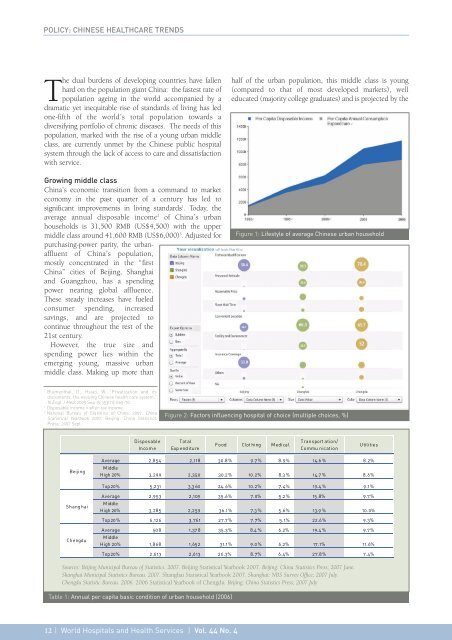World Hospitals and Health Services - International Hospital ...
World Hospitals and Health Services - International Hospital ...
World Hospitals and Health Services - International Hospital ...
You also want an ePaper? Increase the reach of your titles
YUMPU automatically turns print PDFs into web optimized ePapers that Google loves.
POLICY: CHINESE HEALTHCARE TRENDS<br />
The dual burdens of developing countries have fallen<br />
hard on the population giant China: the fastest rate of<br />
population ageing in the world accompanied by a<br />
dramatic yet inequitable rise of st<strong>and</strong>ards of living has led<br />
one-fifth of the world’s total population towards a<br />
diversifying portfolio of chronic diseases. The needs of this<br />
population, marked with the rise of a young urban middle<br />
class, are currently unmet by the Chinese public hospital<br />
system through the lack of access to care <strong>and</strong> dissatisfaction<br />
with service.<br />
Growing middle class<br />
China’s economic transition from a comm<strong>and</strong> to market<br />
economy in the past quarter of a century has led to<br />
significant improvements in living st<strong>and</strong>ards 1 . Today, the<br />
average annual disposable income 2 of China’s urban<br />
households is 31,500 RMB (US$4,500) with the upper<br />
middle class around 41,600 RMB (US$6,000) 3 . Adjusted for<br />
purchasing-power parity, the urbanaffluent<br />
of China’s population,<br />
mostly concentrated in the “first<br />
China” cities of Beijing, Shanghai<br />
<strong>and</strong> Guangzhou, has a spending<br />
power nearing global affluence.<br />
These steady increases have fueled<br />
consumer spending, increased<br />
savings, <strong>and</strong> are projected to<br />
continue throughout the rest of the<br />
21st century.<br />
However, the true size <strong>and</strong><br />
spending power lies within the<br />
emerging young, massive urban<br />
middle class. Making up more than<br />
half of the urban population, this middle class is young<br />
(compared to that of most developed markets), well<br />
educated (majority college graduates) <strong>and</strong> is projected by the<br />
Figure 1: Lifestyle of average Chinese urban household<br />
1.<br />
Blumenthal, D., Hsiao, W. “Privatization <strong>and</strong> its<br />
discontents: the evolving Chinese health care system.”<br />
N Engl J Med. 2005 Sep 15;353(11):1165-70.<br />
2.<br />
Disposable income = after-tax income.<br />
3.<br />
National Bureau of Statistics of China. 2007. China<br />
Statistical Yearbook 2007. Beijing: China Statistics<br />
Press; 2007 Sept.<br />
Figure 2: Factors influencing hospital of choice (multiple choices, %)<br />
Disposable<br />
Income<br />
Total<br />
Exp end iture<br />
Food Clothing Medical<br />
Transport ation/<br />
Commu nicat ion<br />
Utilities<br />
Beijing<br />
Average 2,854 2,118 30.8% 9.7% 8.9% 14.6 % 8.2%<br />
Middle<br />
High 20% 3,299 2,350 30.2% 10.2% 8.3 % 14.7 % 8.6%<br />
Top20% 5,231 3,3 60 24. 6% 10.2% 7.4% 19.4 % 9.1%<br />
Shanghai<br />
Chengdu<br />
Average 2,953 2,109 35.6% 7.0% 5.2% 15.8% 9.7%<br />
Middle<br />
High 20% 3,285 2,259 36.1% 7.3 % 5.6% 13.9 % 10.0%<br />
Top20% 6,126 3,761 27.7% 7.7% 5.1% 22.6% 9.3%<br />
Average 50 8 1,37 8 35.3% 8.4 % 6.2% 19.4 % 9.7%<br />
Middle<br />
High 20% 1,868 1,652 31.1% 9.0% 6.2% 17.1% 11.6%<br />
Top20% 2,613 2,613 26.3% 8.7% 6.4% 27.8% 7.4%<br />
Sources: Beijing Municipal Bureau of Statistics. 2007. Beijing Statistical Yearbook 2007. Beijing: China Statistics Press; 2007 June.<br />
Shanghai Municipal Statistics Bureau. 2007. Shanghai Statistical Yearbook 2007. Shanghai: NBS Survey Office; 2007 July.<br />
Chengdu Statistic Bureau. 2006. 2006 Statistical Yearbook of Chengdu. Beijing: China Statistics Press; 2007 July<br />
Table 1: Annual per capita basic condition of urban household (2006)<br />
12 | <strong>World</strong> <strong><strong>Hospital</strong>s</strong> <strong>and</strong> <strong>Health</strong> <strong>Services</strong> | Vol. 44 No. 4
















